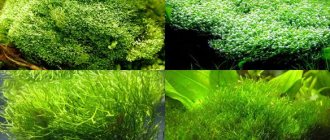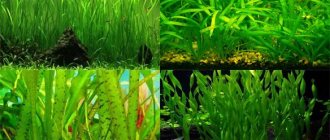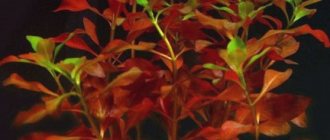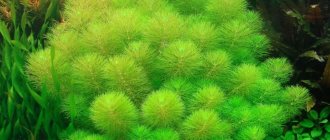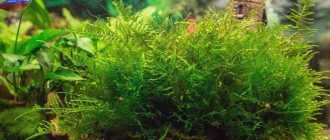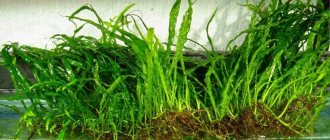The naiad or naias is a common aquarium green, and in nature it can grow almost anywhere except the most inhospitable northern regions. Some people know it under the name rezuha - an annual aquatic plant with long stems immersed in water. In total, about 50 species of nayas are known, and only eight can be found in Russia. All species have long branched stems on which are located narrow (almost like threads), fragile and relatively rigid whorled leaves. They have a poorly developed root system.
The naiad is an annual plant: it blooms, produces fruits and dies. It is pollinated underwater to produce a juicy fruit with one seed.
Main aquarium species
The most popular among aquarists are the following:
| Kinds | Description |
| It came from Central and South America and has denticles along the edges of the leaf blades. The length of the leaves is from 2 to 3.5 cm, the width is 1.5 mm, which are collected in fluffy whorls. The color is green of varying intensity, red-brown. The roots are weak. |
| The leaves are larger and much tougher, the root system is powerful. The leaves are translucent and emerald green in color, but intense light can cause a red tint to appear at the ends of the leaf blades. The stem is fragile and covered with thorns. Habitat: southeast Asia. |
| Came from North and South America. It grows up to 50 cm. The leaves are small and narrow in structure, have a rich green color, and are collected in three false whorls. |
| It has very picturesque dark burgundy cloves that border dark green curved leaves. In bright light, the leaves begin to shimmer in different shades, which causes a unique effect. The roots are weak, which is why the bushes often float in the water. But they can also attach to snags. |
| It has twisted light green leaves, which are collected in whorls of 5-6 pieces. It grows up to 50 cm. When flowering, you can see pretty white flowers of three petals, in the center of which there are yellow stamens. |
| Flexible (N. Tenuissima) | Can be seen in the fresh waters of lakes in the European part of Russia, Altai. Their stems are brittle, the leaves are light green and narrow. If you take a piece from natural reservoirs, it will take root well in aquariums. |
| Herbaceous (N. Graminea) | Came from England, has thread-like long leaves of light green color. It can grow very well and quickly, and very graceful and lacy plantings are formed. |
Varieties of Nayas
Of all the types and varieties of nayas, only a few are popular among aqua designers.
Nayas Roraima
One of the most beautiful and impressive varieties. It was recently released and is still rare and also not cheap. It was first created in Japan, from where it quickly spread throughout the world. This variety has a weak root system, and the leaves, on the contrary, are very strong and rigid, curved, with teeth.
They are bright green in color, shaded with brownish and burgundy streaks, which creates an original pattern. One of the advantages of the Roraima nayas is that it can be either released to drift freely in the water column or rooted in the ground.
In terms of its requirements, this variety is as unpretentious as all its relatives. You just need to note that he loves quiet, standing water, so it is better to plant him in an aquarium away from filters and aerators.
Did you know? The Najas graminea species
is considered a weed in Asia that infests rice fields.
Guadalupe
The Guadalupe najas (Najas guadalupensis) is distinguished by its grace; this is one of the most beautiful views. Small elongated leaves reach a length of 3.5 cm and a width of no more than 2 mm.
In the upper part of the shoot they are more densely crowded and bend slightly, visually forming a fluffy whorl. Unpretentiousness and sophistication are the main advantages of this plant, inherent in all its varieties.
Indian (royal)
This species (Najas indica), as its name suggests, is native to eastern and southern Asia. The most remarkable thing about it is the hard and long leaves of emerald green color, forming spectacular brushes on the tops of the stems. If the plant receives powerful light for a long time, some of the leaves acquire dark or reddish shades.
We recommend that you familiarize yourself with the ten best plants for an aquarium.
The root system of the Indian Nayas is perhaps the strongest among all varieties of the genus. But, if necessary, representatives of this species grow well in the water column.
Grassy
A wonderful variety that opens up wide scope for designers’ imagination. Its leaves, light green and narrow, form an excellent background for phytodesign elements with a wide leaf.
Important! To maintain the thickness and shape of the nayas you need, you need to thin it out regularly - if left uncontrolled, it will quickly grow and greatly darken the aquarium.
Content Features
These types of aquatic inhabitants are characterized by high growth and reproduction rates, so they are universal for beginners. Under good conditions, the bushes can grow quickly and form dense thickets. Moreover, the seasons do not affect the rate of growth and development. The main content requirements include the following:
- The naiad loves “tropical” water (20-25 degrees), although it can adapt to large changes;
- at low temperatures its metabolism decreases, the plant may die; some species like lower temperatures: egeria feels good at 15 degrees;
- higher temperatures lead to increased fragility of the stems and damage to them by fish;
- it is not demanding of good lighting and can withstand long periods of darkness, but sunlight and fluorescent lighting accelerate growth and development;
- does not significantly react to the nature of the soil, because it can simply float, but is better rooted in gravel or river sand;
- It is advisable to change the water weekly in a volume of 25-30%.
Too soft water will slow down the growth of nayas.
With good growth, regular trimming and removal of excess parts, dried fragments, and debris is required so that they do not interfere with the movement of the inhabitants of the aquarium.
With a lack of light, it can lose its rich color and acquire dull shades. Reacts more to the intensity of light than to its duration. With good filtration, the bushes grow much faster.
To maintain the attractiveness of the bushes, fairly frequent transplants are needed. Indeed, due to poorer illumination in lower layers, a loss of a beautiful appearance, the appearance of pallor and elongation are possible.
Description
Nayas is considered an algae and several species of this plant are immediately distinguished, the differences among which boil down to the presence of individual characteristics in appearance. In Russia, only 3 types of algae are the most popular: Guadalupe nayas, Indian nayas and Roraima nayas.
All types of algae are characterized by rapid growth, a high rate of adaptability to the external environment and the ecosystem in the aquarium with fish.
Nayas is characterized by a poorly developed root system. For a plant to grow, it doesn’t even have to be planted in soil. The nayas receives all the necessary substances directly from the water, floating freely. It grows very quickly and densely, which sometimes makes it impossible to identify the mother stem the first time. The owner of the aquarium simply sees that a dense plant with a bright green tint has appeared in the aquarium.
Maintenance and care
The shape and size of the aquarium does not matter for the growth of algae. Nayas grows ideally in both round and rectangular aquariums. Despite the large network of stems and leaves, the algae does not interfere with the movement of fish and other inhabitants inside the aquarium.
However, old shoots should be removed. Because they become cloudy and distort the color tone in the aquarium, affecting its attractiveness. On the other hand, removing excess nayas stems is necessary for the smooth movement of fish in the aquarium. But when removing parts of the algae, keep in mind that they break easily, and a separate plant begins to grow from the small stems. This property is very useful in the wild, but is unacceptable for an aquarium.
Editorial: Geophagus red-headed Tapajos
The requirements of this algae for water and temperature cannot be called special: water of any hardness is suitable, but it should be remembered that in water with low hardness, nayas does not grow so quickly. The optimal temperature range is considered to be 15-30°C. You should also change the water every week, which is normal for aquariums.
Nayas get their nutrition from the organic activity of fish and other inhabitants of the aquarium, so mineral feeding is not necessary. Like any other aquarium plant, nayas need enough. The nature of the lighting does not matter; even artificial lighting will do. With a reduced level of light, although the algae continues to grow and reproduce, the color shade changes and the bright color fades.
Nayas propagates vegetatively. This suggests that a new plant can sprout even from a broken stem. For the propagation process, all you need is the presence of a bud on the stem.
Despite all the efforts expended, the nayas is a useful inhabitant in the aquarium. Because, in addition to its aesthetic appearance, it fills the water with oxygen and is an additional incentive for fish spawning. Since it is convenient for fish to leave eggs in leaves and a large number of stems. In nature, nayas are one of the best means of protecting young animals from predators. In addition, the algae absorbs all organic substances released by the fish in the aquarium.
Landing rules
After purchasing a bush or cutting, it must be inspected in order to remove damaged or rotten areas. It is advisable to disinfect with a weak solution of potassium permanganate to prevent foreign pests and possible parasites from entering the tank.
During the planting process, usually no problems arise, since the nayas does not require mandatory fixation in the soil. He feels quite comfortable floating in the water. If you want to prevent the plant from “dangling” under the flow of the filter, it can be attached to any developed bush. And if the design of the aquarium dictates constant and unchanging decorations, it is quite enough to stick a piece of the cutting into the thickness of the substrate. After such a simple planting, the formation of the root system begins. Although thin roots are formed, they are still able to hold the bush in one place.
Keep in mind that the naiad can do without soil at all, receiving nutrition through the leaves. That is why it is considered a very good option for landscaping both spawning grounds and main aquariums with almost no soil.
Habitat
The plant of the watercolor family has several names: naiad, rezukha, najas. It has been used for decorative purposes in home ponds for a long time, since the 19th century, but today these marvelous green laces are undeservedly forgotten, while the plants are unpretentious and do not require special care.
Nayas grows in tropical regions of all continents, including in the south of Russia, excluding cold and desert areas. There are different species; a beginner will not be able to determine which one he found in a reservoir. The plant loves fresh and stagnant water, but can also live in slightly salty water, with a slight current.
Features of reproduction
Further propagation occurs using cuttings (vegetative method). All you need to do is break off a piece of the stem with a bud and place it in a tank, from which a young shoot will soon develop, floating freely in the water. After it grows, if desired, it can be rooted.
It must be handled with care due to its fragility. You just need to sprinkle it lightly, and not cover it with heavy pebbles, to avoid damaging the stem.
It is better to choose the most illuminated place, away from bulky plants (nymphea or echinodorus).
Secrets of Table Mountain
For a long time, Roraima remained an uncharted land. Few people dared to climb to the top. And it was not easy to do this due to the fact that the slopes of the mountain are vertical, and they are surrounded by dense tropical forests. Only a few brave Indians made the difficult journey through enchanted forests and impenetrable swamps. And then they talked about extraordinary lands with colored waters in the rivers. All this seemed incredible, and no one took these stories seriously.
The same thing happened to European explorers, who were the first to officially study this area in 1835. These were the scientists Robert Schombourk and Yves Serne. The public laughed at them. And she perceived as fiction the reports that contained descriptions of rivers with colored water, unusual animals and plants. The same thing happened with subsequent expeditions. Who could believe such a fairy tale?
But these studies inspired the famous writer Arthur Conan Doyle. And he wrote a fantastic work, The Lost World. True, he also settled dinosaurs in these places. Only in the 1960s were the works of the next expedition to Roraima seriously studied. This time the participants met giant ants, black frogs that were hatching eggs, and a huge 15-meter snake with a strange head shape.
At one site of unknown purpose, a strange metal powder was discovered. Its chemical analysis showed that it is impossible to obtain such a substance under terrestrial conditions. Therefore, there is a version about space aliens. In confirmation of this, in the labyrinths of quartz caves on Roraima, there are rock paintings depicting strange animals and even humanoids. So the mountain still has many secrets.
Why isn't the naiad growing?
Sometimes improper care and maintenance can lead to deterioration in the growth of this type of plant. The main reasons include the following:
| Factors | Causes |
| Aquarium water | Inconsistency in water quality or composition |
| Lighting | Bad for a long time |
| Fertilizers | Lack of nutrients and CO2 |
| Associated plants | Wrong combination of aquarium plants |
As already mentioned, extremely soft water can cause nayas to stop growing. Long-term light starvation can also cause leaves to turn pale in deeper layers of water.
Expedition to the mountain
More reliable information was obtained 100 years later by the pilot Juan Angel. In search of diamonds in 1937, he flew across the Orinoco River and noticed a tributary that was not marked on the map. Hoping that the river would sooner or later lead him out of the jungle, the pilot continued to follow the stream, and soon it turned out that there was no way to turn aside, since the path was blocked by rocky formations. He flew in the only possible direction until a hill with a flat top appeared before his eyes, on which he landed. However, the plane got stuck in a swampy place. The traveler had to go down the mountain and get to the nearest Indian village. It took more than two weeks. After returning home, he outlined his impressions in a book, describing the amazing flora and fauna of Mount Roraima. A full-scale expedition went to the plateau in 1960. It was led by the pilot's son Rolland.
Do you need fertilizers?
For normal growth and development of the naiad, there are enough nutrients that enter the water of your aquarium along with fish food. Necessary substances are absorbed through leaf blades and from organic waste of life and activity of fish and inhabitants. But still, experts advise applying special fertilizers and feeds for certain species twice a month (Roraima, Egeria need to be fed with liquid forms of mineral fertilizers for aquariums).
Nayas responds well to CO2 “feeding”.
The instructions for certain fertilizers describe in detail both the dosage and method of application. You just need to take into account that the existing powerful filtration systems will partially retain fertilizers in the filters themselves. And there is no need for an overdose; there will only be even more intense growth.
The wonderful world of plants and animals
Most of the flora and fauna are endemic. That is, those that live directly in this limited territory and develop in isolation from the rest. Therefore, they are as unusual as the local landscapes. Due to frequent rains that wash away the soil, there is not much vegetation. There are only islands of greenery with small trees that look like bonsai. In peat bogs you can see strange flowers, carpets of moss and plants that eat insects. The slopes of the mountain are decorated with ferns and gunners, similar to huge burdocks.
The fauna is represented by lizards and scorpions, mice and noses, leeches and spiders. Many of them, including insects, are black. The most amazing are the stone frogs. They are very small - literally a little more than a centimeter. They don't jump as usual, but crawl. But if on the way there is danger in the form of a spider or a scorpion, then they fall down like a stone. They also know how to whistle before the rain.
The role and significance of the naiad in the aquarium
This unpretentious plant performs several functions at once:
- Promotes even greater saturation of water with oxygen.
- It often serves as a spawning site and a good shelter for fry, as well as shrimp and snails.
- Well absorbs excess organic matter that accumulates in the container.
- Gives the aquarium a decorative and aesthetic appearance that is pleasing to the eye.
- Capable of establishing a quick biological balance when starting new aquariums (helps to avoid sudden jumps in the content of ammonia and organic matter).
Before catching fish with a net, it is better to first remove the fish from the aquarium to prevent it from breaking into small pieces.
To create the right aquatic landscape, it is better to plant it near the back walls in order to create a spectacular background for both the inhabitants and other aquatic plants with the same development conditions. Hornworts, riccia, echinodorus, duckweed, moss, and ferns look good here.
The popularity of the naiad, great possibilities for creating design solutions, ease of care and further reproduction have made it one of the favorite inhabitants of aquariums of various sizes.
Design
When you first get acquainted with the crossover, one glance is enough to appreciate the enormous amount of work the designers did to create the car’s exterior. Ideal shapes and smooth relief lines make the new 2021 Roewe RX5 a luxurious representative of a wide range of latest-generation SUVs.
Editor's note: Glossolepis red
Thanks to chrome elements, the radiator grille completely merges with the headlights, which makes the already expressive appearance of the model stylish and modern. A massive bumper with a wide air intake slit and L-shaped inserts around the fog lights gives confidence to the image.
From the side, the crossover has a lot in common with many modern representatives of the SUV segment, but despite the classic forms, each element of the body contains pronounced relief lines that create a sweeping image of the model, and the rising line of the side windows, the slope of the front window and the distinct radius of the falling roof indicate high speed characteristics of Roeve RX5 2020. Protruding wheel arches, decorated with plastic linings of a classic crossover body kit, organically fit into the overall concept of body design.
The real decoration of the car is the stern with smooth horizontal curves, against which the trunk door is completely invisible. The originality of the image is given by wedge-shaped rear lights connected by a chrome strip of decor and a stylish bumper layout with oval exhaust outlets.
When designing the interior space, the manufacturer used rather original methods of approach. As a result, the crossover received a combined front panel with a large vertical touchscreen monitor, which leaves conflicting emotions upon initial acquaintance with the interior.
Classic front seats with headrests have minimal lateral support and cannot provide a high level of comfort, although the high seating position guarantees a good view from the car interior. The flat rear bench has enough space to accommodate three adult passengers, including the middle one, due to the absence of a projection in the transmission tunnel. However, as in the case of the front seats, there is an almost complete absence of lateral support bolsters.
Of course, the car will please you with its spacious luggage compartment, which allows you to transport quite large loads. If necessary, its size can be increased almost 3 times by folding the rear seats.
Luggage compartment volume (maximum) 1639 l Fuel tank capacity 55 l
Length 4545 mm Width 1855 mm Height 1719 mm Wheelbase 2700 mm
Tips for aquarists
You can attach the Naiad to the wall of the aquarium using a suction cup.
Before you add a naiad to your aquarium, here are some helpful tips to consider:
- when purchasing, do not confuse the naiad with elodea, whose leaves are larger, wider and without teeth;
- It is convenient to attach the naiad to the wall of the aquarium using a silicone suction cup;
- To prevent the plant from being “tossed around” by the current from the filter, hook it to the bush of a plant such as cryptocoryne, firmly seated in the ground;
- If you decide to plant a naiad from a natural reservoir in an aquarium, keep the plant in quarantine for 15-20 days.
Ludwigia
Ludwigia is an aquarium plant from the Fireweed family. The most common species in aquariums are Ludwigia creeping, arcuate and swamp. Experts do not agree on the care of such a plant. According to some, this is an absolutely unpretentious plant that does not require special care and grows well. According to others, caring for Ludwigias will require some experience and skill. However, it is known for sure that if a plant is placed in relatively favorable conditions, it will quickly adapt to new conditions and will actively grow and develop.
Ludwigias grow up to 36 cm and bloom profusely with small green flowers. And Ludwigia repens also produces flowers with yellow petals.
Ludwigia is an aquarium plant that will add uniqueness to any aquarium, and the huge selection of varieties can satisfy any taste.
Mountain climbing
You can admire the majestic landscapes of the mysterious mountains of the Guiana Plateau not only from above during a helicopter ride. Every day, several dozen tourists climb the plateau along special routes. Before this, training programs are carried out. Climbing on your own is quite dangerous, and it is also prohibited by law. The path to Mount Roraime begins in an Indian village. As a rule, on the first day, tourists have to walk about 20 km through the mountain steppes, fording two rivers. After heavy rainfall, moving through this area can be difficult. In some places, travelers will even be able to walk through waterfalls. And in some places you will have to climb steep rocks, for which you will need reliable shoes and special equipment.
It is best to travel with a guide. As a rule, these are local residents - the Pemon Indians. Many of them speak Spanish well. Those who require a guide who speaks English should make prior arrangements. Standard tours take about 5-7 days and focus exclusively on the southwestern part of the plateau.
Tepui - the lost world of the ancient gods
Mountains with smooth steep slopes and a truncated flat top are called “table mountains”. They are usually composed of sedimentary rocks. They are found in different parts of the world: Gamsberg in Namibia, Monte Santo and Monte San Antonio on the island of Sardinia, Sierra Negro in Argentina.
The hills with plateaus located on the Guiana Plateau are called “tepui”. These giant sandstone massifs are considered the oldest rock formations on the planet. In the language of the Pemon Indians who inhabit the surrounding areas, the word "tepui" means "house of the gods." One of the most famous is the Roraima table mountain. At first glance, the hills shrouded in thick fog resemble the scenery of a science fiction film. Tepuis are located in one of the least explored corners of the planet. For many centuries, this region remained mysterious and unexplored, giving rise to all sorts of legends, myths and stories about the lost areas of a fantasy world. Until the 19th century, Europeans could not discover Mount Roraima in South America. Therefore, the region, shrouded in an aura of mystery, was for a long time considered an invention of the Indians.
Myths and legends about the mountain
Numerous myths are associated with this mountain. The Pemon and Capon Indians have passed on legends to their descendants for centuries. According to one of the legends widespread among the local Indians, the plateau is a landing site for guests from heaven.
According to another legend, the flat-topped mountain is a giant stump that remains from a tree of incredible size. All the fruits in the world grew on it. The tree was cut down by a hero of legends named Makunaima. After the fall of a huge trunk, a powerful flood formed on the ground. It is quite possible that this fairy tale is an echo of a natural disaster.
Another legend from residents of nearby villages says that the mountain is the habitat of the goddess Quinn, the ancestor of all humanity.
In the early 2000s, researchers discovered a cave system called Cueva Ojos De Cristal, which means “Cave of Crystal Eyes” in Spanish. It owes its name to quartz formations. Numerous ancient rock paintings were also discovered there. On some walls there are paintings of prehistoric animals or creatures that vaguely resemble humans. The depth of the cave reaches 72 m. Natural tunnels extend for 11 km. 18 exits detected.
Many local residents are afraid to approach the “Mother of the Great Waters” - Mount Roraima, fearing evil spirits.
Ferns
Ferns are another record holder for their ability to survive in various conditions. The following types of ferns are in demand among beginning aquarists:
- Thailand - the plant does not require lighting and does not need rooting - the Thai fern attaches to objects using rhizoids. It grows slowly and feels comfortable at a temperature of 24C.
- Indian fern - representatives of this type of fern can float freely on the surface of the water surface, or be planted in a substrate. When choosing the second option, you should take into account that sand or a fine substrate is suitable as soil for the Indian fern.
